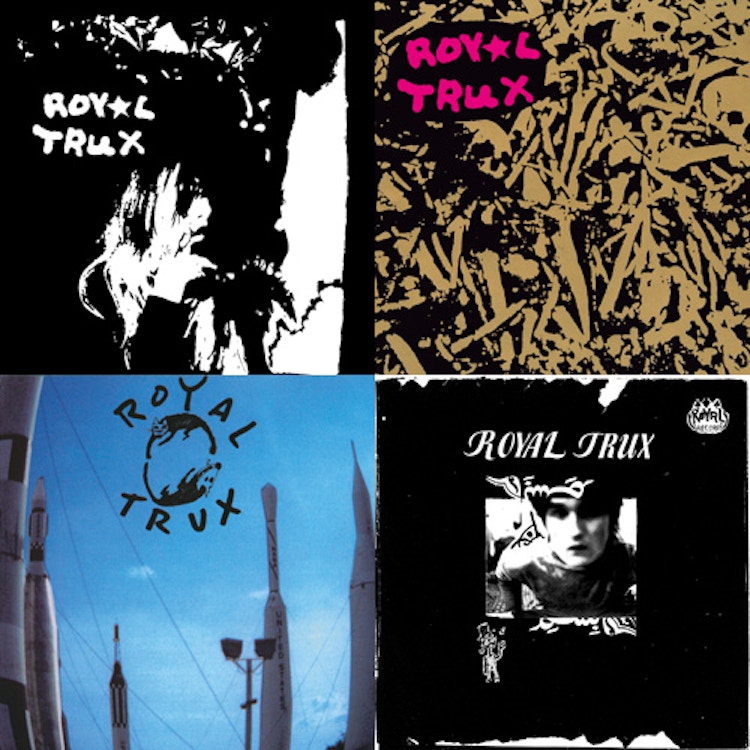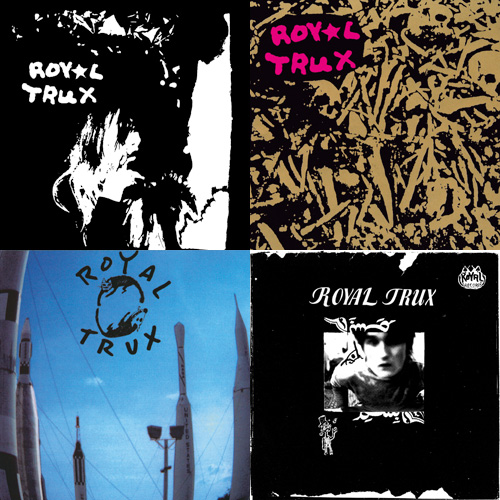"Royal Trux / Twin Infinitives / Untitled / Cats And Dogs"

When blues inflected, scuzzy, frankly balls-out rock’n’roll came into prominence on the back of the White Stripes wave in the first third of the last decade, Royal Trux would often be referred to as one of the prefiguring bands from the previous decade who didn’t gain their dues despite playing much the same way. Well, that’s as maybe for posterity’s sake. Revisiting their first four albums to look for pointers, though, is a tricker proposition. Here we find the formulation of a sound collage in which bluesy FM rock, Stooges heavy riffs, Velvets narco-noise and free jazz chaos theory accelerate into each other, leaving Washington DC’s poster couple for heroin chic to pick through the remains and see what Frankenstein’s monsters they could build and call albums.
Neil Hagerty and Jennifer Herrema met in 1987. Until 1990, Hagerty was guitarist with Washington based garage-noise outfit Pussy Galore, better known as Jon Spencer’s pre-Blues Explosion project, but wanted an escape valve for his own visions. Hagerty has said the initial aim with Royal Trux was to combine Black Sabbath and Ornette Coleman; the self-titled 1988 debut is more like Captain Beefheart’s skewiff blues played by people you wouldn’t trust to be able to sit up straight. ‘Bad Blood’ opens the account with detuned riffs and confusing runs while Hagerty acts like he’s making a very late attempt to get on garage rock’s seminal mid-60s Nuggets compilation. From then on it’s clattering guitar noises approximating chords, occasional appearances for Herrema’s nicotine-stained holler, nods to blues traditions (‘Strawberry Soda’), No Wave clatter (‘Esso Dame’) and every so often a shard of song structure just before the edifice, and possibly band membership, collapses. Everything is delivered with menace and sleaze, played with a conviction that belies ability and in thrall to jazz skronk. Instrumental ‘Hashish’, not far over two minutes long, manages to forget where and what it is at least twice.
Compared to 1990′s Twin Infinitives, that album is Scouting For Girls. Three years afterwards Stereolab unconsciously came up with a more accurate title, Transient Random Noise Bursts With Announcements. Both sporting heavy drinking habits, the pair’s attempt to move away from alcoholism came through the not entirely Paul McKenna-approved means of developing heroin addictions. Atonal, seemingly random messthetics pervade, sounding resolutely damaged even if Hagerty says it was all written and recorded while sober (admittedly, he concedes not very often). Influences – the blues-damaged stonewalling to outsiders of Beefheart’s Trout Mask Replica, Sun Ra’s space freakouts – are writ large but this is resolutely their own space, vocals that are either come-on threatening (Herrera) or disturbed hollering (Hagerty) fighting for air with walls of guitar scree, synth bubble, slashing machine noise, tape loops, distortion and low end churning. Sometimes even linear bits of songs emerge from somewhere under the burbling, clanging and scraping feedback. The vocal line submerged on ‘Ice Cream’ seems in need of its natural home in widescreen porch blues; ‘RTX-USA’ features a heroic Lynyrd Skynyrd guitar lick being trampled to death by sentinent arcade machines. A reggae lope seems to be trying to break out of the house of horrors evoked by ‘Yin Jim Versus The Vomit Creature’. The whole thing comes to a head on ‘(Edge Of The) Ape Oven’, fifteen minutes of fragments of instruments, warped dual vocal lines and drum programming pretending any of it is in time with each other, gradually becoming more woozy and vari-speeded as a hair metal solo keeps threatens to escape. The album ends with some narcoleptic pub piano boogie. On the one hand its influence exists from the Boredoms to Liars’ less accessible screes; on the other attempting to capsule review the whole experience twice gave this writer a raging headache.

From that dark pit there was only one direction to go. Officially Untitled but known by some as again self-titled or as Skulls, 1992′s third album begins with a new sound to anyone accustomed to their work so far, the strum of an acoustic guitar. Hagerty once persuaded Pussy Galore to re-record the whole of Exile On Main Street for a cassette release, and on this album that becomes easy to believe (see ‘Lightning Boxer’) as their take on the blues abandons the trappings on the outer reaches and heads for warmer while still woozier trad rock and roll pastures. That first track, ‘Air’, lolls along with West Coast pop-folk pretensions towards ‘Wild Horses’ territory, while ‘Junkie Nurse’ is a classic Dylanesque acoustic ballad with a not exactly cryptic undertow and a brief, inspired outbreak of fingerpicking. Herrema found her voice too, a forceful, sleazy cawing counterpoint to Riot Grrrl, wrapped in primeval bleakness. There’s still plenty of psychedelic dissonance in the playing, especially the White Light/White Heat rush of ‘Sun On The Run’, but the production is cleaner without being particularly hi-fi, meaning the Burroughsian pulp fiction lyrics are more effective.
With the addition of a rhythm section, 1993′s Cats And Dogs allowed room to extend the brief from Stones jams out to the classic rock of their youths – ZZ Top, Creedence Clearwater Revival, some Led Zep, essentially most things choogling – mixed in parts with Sonic Youth’s disorientating experiments in guitar rock – white noise instrumental piece ‘Friends’ the only direct concession to where they came from. Here our dynamic duo, duetting in the loosest sense of the term more than ever before, are portrayed as strutting, slurring hipsters with heads full of Keith Richards. They’re happy drawing out the sidewalk sleaze of ‘The Flag’ and ‘Hot And Cold Skulls’ with the aid of divebombing, churning riffs, then gathering round late at night for the tribal percussive mysticism story ‘The Spectre’, later commandeering a spit’n’sawdust joint back room for the bottleneck and wah pedal driven bar band counter-anthem ‘Skywood Greenback Mantra’. ‘Driving In That Car (With the Eagle on the Hood)’ closes matters with a malevolently seductive Herrema helming a synth sci-fi odyssey amid the lofty drones of a backwoods Suicide. It sounds like people dancing round the bonfire on which most of their possessions are burning, issuing invitations for unspecified fun to all passers-by.
This by now being 1994, thus post-Nirvana, all this was enough to get Royal Trux signed to Virgin for an amount that bought Herrema and Hagerty a proper isolated ranch in the hills of Virginia, part of which was transformed into a studio. The pair claim to have straightened out around this point, Herrema somehow ending up as a Calvin Klein model. They released two albums under the major label watch, one of which featured a filthy toilet on the cover. Shortly after that they were let go, returning to Drag City (and Domino in Europe, under whose auspices these reissues arrive) for three further records and some of the best reviews of their career (check 1998′s Accelerator) before splitting both personally and professionally, Hagerty now working as The Howling Hex and under his own name, Herrema as the increasingly hair metal indebted RTX.
To say there are two Royal Trux identities at work here isn’t entirely accurate. Somewhere under the noise, dissonance and fury of the first two are embers of the blues rock maliciousness that act as foundation for albums three and four, though it’s unlikely that anyone making the reverse journey will be as keen. They were, essentially, a band that did things as they came to them, whether junkie music concréte or an alien Sticky Fingers. The former needs a will of iron at times to wade through the abstractions, the latter an appreciation that 70s US radio classic rock can harbour a jagged alternative edge.
Get the Best Fit take on the week in music direct to your inbox every Friday

Lorde
Virgin

OSKA
Refined Believer

Tropical F*ck Storm
Fairyland Codex





